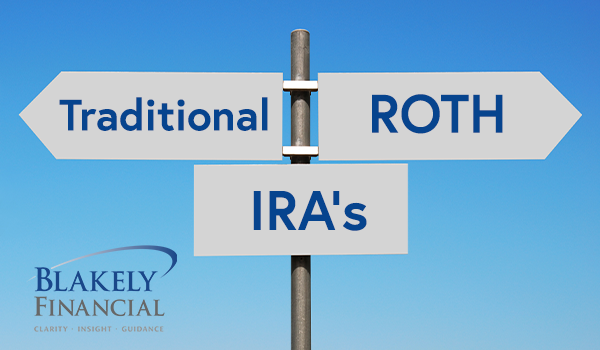Traditional IRA Vs. Roth IRA: Choosing the Best Fit
Presented by EMILY PROMISE CFP®, AIF®, APMA®, CRPC®
IRAs are a type of savings account designed to help you put money away for retirement in a tax-advantaged way. Two of the most common types are traditional and Roth IRAs. How do you know which one you should invest in? There are several factors to consider, so let’s take a closer look at their similarities and differences to help you choose the best fit.
The similarities between traditional and Roth IRAs include the following:
- Contribution limits: Total annual contributions to your traditional and Roth IRAs combined cannot exceed $6,000 if you are younger than 50 or $7,000 if you are age 50 or older.
- Contribution deadline: The deadline is the same as your tax return filing deadline (not including extensions).
- Withdrawals: You can withdraw money at any time, but distributions may be subject to tax and penalty. For traditional IRAs, withdrawals prior to age 59½ may be subject to a 10 percent premature withdrawal penalty, unless an exception applies. For Roth IRAs, withdrawals of the principal are tax and penalty-free. If you are younger than 59½ and have had the account for less than five years, however, you may have to pay taxes and/or a penalty on any earnings withdrawn.
- Rollovers: Direct rollovers are accepted from outside qualified retirement plans (i.e., 401(k)s), and they may be taxable.
There are, however, some key differences between these account types, as summarized below:
- Traditional IRAs
- Contributions may be tax-deductible, depending on your income level.
- Contributions grow tax-deferred, meaning you pay taxes only when you withdraw the money.
- You must begin taking required minimum distributions (RMDs) at age 72*.
- Roth IRAs
- Not everyone is eligible to contribute; income restrictions apply.
- Contributions are not tax-deductible. But distributions are tax-free if the account has been open for at least five years and the account owner is age 59½ or has qualified for an early withdrawal exception.
- Roth IRAs do not have RMDs.
There are a lot of details to take into consideration before deciding on which account you would like to open, and it’s important to be well-informed before making a decision. If you have further questions regarding either type of IRA and which one would be best for you, we welcome you to contact us.
Engage with the entire Blakely Financial team at WWW.BLAKELYFINANCIAL.COM to see what other expert advice we can provide towards your financial well-being.
EMILY PROMISE is a financial advisor with BLAKELY FINANCIAL, INC. located at 1022 Hutton Ln., Suite 109, High Point, NC 27262 and can be reached at (336) 885-2530.
Blakely Financial, Inc. is an independent financial planning and investment management firm that provides clarity, insight, and guidance to help our clients attain their financial goals.
Securities and advisory services offered through Commonwealth Financial Network, Member FINRA/SIPC, a Registered Investment Adviser.
Prepared by Commonwealth Financial Network®
*If you turned age 70½ before January 1, 2020, then you must begin taking RMDs at age 70½.

